Giving back is in our Fotostrap DNA. In addition to empowering and equipping our community of storytellers, we were founded to help support the nonprofit Fotolanthropy, which uses film and photography to chronicle powerful true stories about those who have defied great odds. To be a part of something big and redemptive fuels our spirits, and we greatly admire individuals who use their time and talent to serve others. What's beyond inspiring is that we've learned about so many of you who do just that. In our new series The Golden Hour, we're excited to use our blog space to highlight photographers who use their camera for good. September is Childhood Cancer Awareness Month and we are honored to feature The Gold Hope Project, a nonprofit that is giving back to families battling pediatric cancer through photography while raising awareness and funds for a cure!

Tell us about the mission of The Gold Hope Project and why it was founded?
The heart of The Gold Hope Project is to bring awareness to childhood cancer through photography while also funding innovative cancer research. It can be easy to think of cancer, especially when it affects children, as something that won’t happen to you or someone you know but when our supporters see the faces of the children and families who childhood cancer is affecting daily, it becomes so much more real.
The Gold Hope Project was inspired by my daughter Ava. When Ava was only 4 years old, she was diagnosed with a terminal brain tumor called DIPG. Unfortunately, there is no cure or known treatment for this type of cancer and most children with DIPG will pass away within two years after diagnosis.

This news crushed my family and we wanted to give her a fighting chance but that just wasn’t possible. I knew that our time together would need to be filled with making lots of memories and that included a lot of photos. Ava was the first fighter photographed for the organization a month before her death in 2011. Her glitter filled session was full of laughter and so many smiles. I’m forever grateful for those images and the memories I hold from that day with her.
Since Ava’s gold hope session, we have been able to give the gift of photography to over 775 families and have contributed to providing research grants for pediatric brain cancer research totaling more than $500,000. Something I hope she could be proud of today.
What is your role with the organization today?
We are very much a grassroots movement so I have many different roles within the organization but the main one is President and chief operating officer. Besides the parents of the children we photograph who bravely share their struggles and strengths with our audience, I also give a voice to the children who are dealing first hand with the devastation that cancer brings.
What does a Gold Hope Project portrait session look like for each child?
It is our hope during their gold hope session, each family and child can just be with each other. Their life can be very challenging filled with busy treatment schedules, constant care, and worry. Sometimes they are also separated from one parent or siblings. We want to bring moments of joy to them at their session. This can look different for each child. Whether it is letting them play with lots of glitter, arranging for them to meet their favorite princess, granting them access to their favorite sports team's field, or just being with their family- we try our best to allow them to forget for a moment what they may be facing and let their inner light and love shine.
Approximately how many volunteer photographers work with TGHP? What does their dedication mean to you and the families you serve?
Our volunteer photographers mean everything to us! It is because of their generosity that we are able to share this amazing gift with so many families throughout the country and even overseas. To have over 675 photographers who believe in our mission and who are willing to help this cause means so much to not only me but all the families we have photographed.
Do you offer any training or resources for your volunteer photographers?
We offer guidance and suggest some best practices for working with childhood cancer patients but we typically leave it up to them to ask for help if they need it. Luckily, we have a great online group where any photographer can reach out and ask for advice. Other photographers have been able to suggest ways to incorporate gold into their session or offer ways to support a family who may have lost their child. Having a welcoming place to go is a nice way for our volunteers to engage and share with one another.


Tell us about the mighty fighters you get to photograph. What is most special about capturing them?
This is a hard question to answer because our fighters are so special in so many ways. I’d say the main thing that stands out is their ability to smile and laugh through the pain. Children are amazing and especially these children who have been through so much in their short lives but still continue to live in a way that is inspiring to everyone they meet. They don’t dwell on their illness, the medicine they need to take, or the fact that they may need to be in the hospital for weeks on end. Life is still an amazing adventure to them! We can all learn so much by watching their spirit and how they treat each day.
What has been the most rewarding part of running TGHP?
There are so many aspects of the organization that bring me so much joy I don’t think I can name just one. I do have to say it is pretty incredible that we have been able to photograph over 775 families and something that makes me so proud is thinking that Ava lives on through each session we do. The feedback from the families is super rewarding to hear and lets me know we are doing incredible things for them. Photography is a gift and sometimes it takes a major life event to realize that.
What do you wish people knew about pediatric cancer?
So much! Before I was thrust into the childhood cancer world, I had so many preconceived notions of this illness, mostly because of what I saw on tv commercials. There were a lot of sad truths I had to learn. Like, not all children diagnosed with cancer will lose their hair, mainly because there is no chemotherapy that will cure them. And that childhood cancer is severely underfunded. The National Cancer Institute (NCI) only allocates 4% of their budget to the 16 different kinds of childhood cancer (yes 16!) while single adult cancer receives the other 96%. This lack of funding affects drug trials, treatment plans, research, and so much more.
Cancers like the one Ava was diagnosed with have the same survival rate, zero, as they did more than 50 years ago. I learned this soon after her diagnosis and it shocked me to my core. I had no idea a child could be diagnosed with terminal cancer, let alone how stalled some of the treatments were.
If more funding was available, I strongly believe that researchers could make progress with some of the childhood cancers that have such a grim prognosis. This could lead to a cure for so many other cancers. This is why a few years ago, we made it a goal of ours to also be involved in funding research for DIPG. When a cure is found, we want to be a part of that!
How can we/the photography industry support the work of TGHP?
The photography industry has been a huge advocate for our organization and the work that we do. Photographers understand the value of photography and the way a photograph can inspire hope in others. The biggest way to continue to offer support is by volunteering. We are always in need of professional photographers throughout the United States (and the world!) who can photograph sessions for any family that may be in need. This is especially true if you are located in an area with a big children’s hospital (like Tennessee) but we get session requests everywhere and the process goes a lot faster if we already have a volunteer in that area.
Another way to show support is by loving on our session shares on social media. The more likes and comments, the more people will see and hear the stories firsthand of how childhood cancer is affecting the families. This goes back to our mission to bring awareness to this disease. More awareness = more funding = a CURE!







